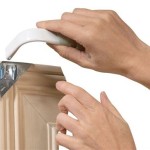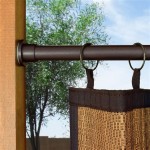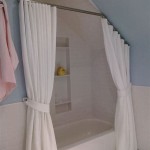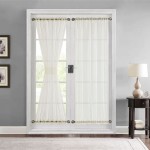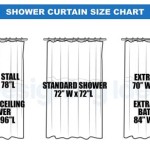Curtain Rod Size for Sliding Glass Doors: A Comprehensive Guide
Selecting the appropriate curtain rod size for a sliding glass door is a crucial aspect of interior design and functionality. The right rod ensures proper curtain support, smooth operation, and aesthetically pleasing window treatment. Ignoring this element can result in sagging curtains, difficulty opening and closing the door, and an unbalanced room appearance. This article explores the various considerations and provides guidance on determining the optimal curtain rod size and type for your sliding glass door.
Understanding the Importance of Overhead Space and Width
The first step in choosing the correct curtain rod size is to assess the available space above the sliding glass door. Adequate overhead space is essential not only for mounting the rod securely but also for creating the illusion of height and allowing for sufficient light when the curtains are fully opened. A general rule of thumb is to mount the curtain rod at least 4 to 6 inches above the top of the door frame. This allows the curtains to extend slightly above the door, making the room appear taller. However, if you have limited overhead space, even 2 to 3 inches is better than mounting the rod directly flush with the top of the door frame.
The width of the rod is equally important. It should extend beyond the width of the sliding glass door on both sides. This extension allows the curtains to be fully drawn to the sides, maximizing the amount of natural light entering the room when desired. A good guideline is to extend the rod at least 6 to 12 inches beyond the frame on each side. This extension can be adjusted based on the overall look you wish to achieve and the desired amount of stack back (the area where the curtains gather when fully opened).
Measuring the space accurately is imperative. Use a reliable measuring tape to determine both the height from the top of the door frame to the desired mounting location and the width of the door frame plus the desired extension on each side. Note these measurements carefully, as they will be critical when selecting the appropriate curtain rod.
Consider the type of curtain being used. Heavier fabrics, like blackout curtains or lined drapes, will require a sturdier rod and potentially more robust mounting hardware. Lighter fabrics, like sheer curtains, may be suitable for a lighter-duty rod. The weight and type of fabric will also influence the amount of stack back, which affects the necessary rod extension.
Finally, consider the overall aesthetic of the room. The height and width of the curtain rod can significantly impact the perception of space. Mounting the rod higher and extending it wider can make a room feel larger and more open. A shorter and narrower rod, on the other hand, may make the room feel smaller and more enclosed.
Choosing the Right Type of Curtain Rod
Once you have determined the required length, the next step is to select the appropriate type of curtain rod. Several options are available, each with its own advantages and disadvantages. The most common types include: standard rods, traverse rods, and decorative rods.
Standard curtain rods are the most basic and affordable option. They typically consist of a simple metal or wooden rod supported by brackets. These rods are suitable for lighter-weight curtains and are easy to install. However, they may not be ideal for heavier fabrics or for sliding glass doors that are frequently opened and closed, as the curtains need to be manually moved along the rod.
Traverse rods are specifically designed for curtains that need to be drawn open and closed frequently. They incorporate a track system that allows the curtains to glide smoothly along the rod. Traverse rods are often used with pinch-pleat curtains and can be operated manually with a wand or cord, or automatically with a motorized system. They are a good choice for sliding glass doors, as they make it easy to control the amount of light and privacy.
Decorative rods offer a wide range of styles and finishes to complement the room's decor. They can be made from various materials, including metal, wood, and acrylic, and may feature ornate finials and intricate detailing. Decorative rods can be used with various types of curtains, but it's important to ensure that they are sturdy enough to support the weight of the fabric. Some decorative rods also incorporate a traverse system for ease of operation.
Beyond these main types, specialty rods also exist. Tension rods can be used in situations where drilling holes for brackets is undesirable, such as in rental apartments. However, tension rods are generally not strong enough to support heavy curtains or for wider sliding glass doors. Double curtain rods provide the option of layering two sets of curtains, such as sheer curtains and blackout curtains, for enhanced light control and privacy.
When choosing a curtain rod, consider the material. Metal rods are typically more durable and can support heavier curtains, while wooden rods offer a more traditional and warmer aesthetic. The finish of the rod should also complement the hardware and other design elements in the room. Black, bronze, and brushed nickel are popular choices for metal rods, while wood rods can be stained or painted to match the room's decor.
Considering Weight and Support
The weight of the curtains is a critical factor in determining the appropriate curtain rod size and the necessary support. Heavy curtains, such as blackout curtains or lined drapes, require a sturdier rod and more robust mounting hardware than lighter fabrics. Using an undersized rod or inadequate brackets can result in sagging, bending, or even the rod pulling away from the wall.
When selecting a curtain rod, check its weight capacity. The manufacturer's specifications should indicate the maximum weight the rod can support. Choose a rod with a weight capacity that exceeds the actual weight of your curtains to ensure adequate support and prevent sagging. If you are unsure about the weight of your curtains, you can weigh them using a bathroom scale.
The type of brackets used to support the curtain rod is also crucial. Ensure that the brackets are designed to handle the weight of the curtains and that they are securely mounted to the wall. For heavier curtains, consider using heavy-duty brackets or additional brackets for extra support. When mounting brackets, it is generally recommended to screw them into wall studs whenever possible. Wall studs provide a solid anchor point and prevent the screws from pulling out of the drywall. If studs are not available, use drywall anchors that are rated for the weight of the curtains.
For particularly wide sliding glass doors, consider using a center support bracket to prevent the rod from sagging in the middle. A center support bracket provides additional support and helps distribute the weight of the curtains evenly along the rod. It is particularly important to use a center support bracket for rods that are longer than 8 feet.
The type of curtain heading can also affect the weight distribution. Curtains with grommets or rings tend to distribute the weight more evenly than curtains with rod pockets. Pinch-pleat curtains require a traverse rod with a track system that is designed to handle the weight of the fabric.
Regularly inspect the curtain rod and brackets to ensure that they are still securely mounted. Over time, screws can loosen, and brackets can become damaged. Tighten any loose screws and replace any damaged brackets to maintain the stability of the curtain rod. Consider using thread locker on screws going into wood studs to prevent them loosening over time.
By carefully considering the weight of the curtains and selecting the appropriate curtain rod and support hardware, you can ensure that your window treatments are securely and attractively displayed.
In summary, selecting the appropriate curtain rod size for a sliding glass door involves careful measurement, consideration of fabric weight, and choosing the right type of rod and support hardware. By following these guidelines, homeowners can achieve both functional and aesthetic window treatments.
Curtain Rods For Sliding Glass Door Drapery Direct
What S The Best Curtain Rod For A Sliding Glass Door Design Morsels
What S The Best Curtain Rod For A Sliding Glass Door Design Morsels
Great Curtain Rod Options For Patio Doors Designer Drapery Hardware
What Size Curtain Rod Do I Need For A Sliding Glass Door Upgradedhome Com
Curtain Rod Size For Sliding Glass Door Window Curtains
10 Patio Door Curtain Ideas You Ll Love
5 Sliding Glass Door Curtain Rod Facts You Must Know Aprylann
Sun Zero Conrad Extra Wide Blackout Sliding Patio Door Curtain Panel Wal Com
Diy Sliding Door Curtain From A Blanket Walls Of Wonderland


